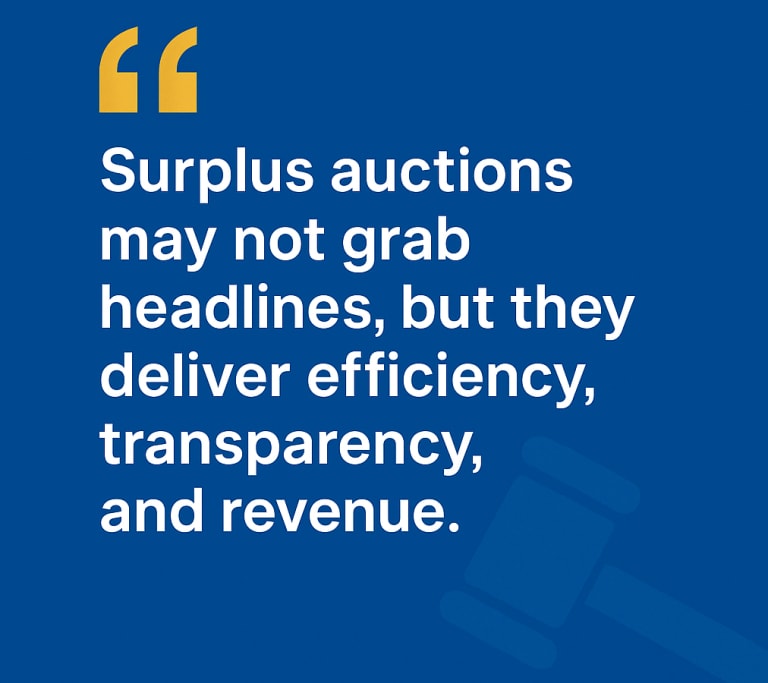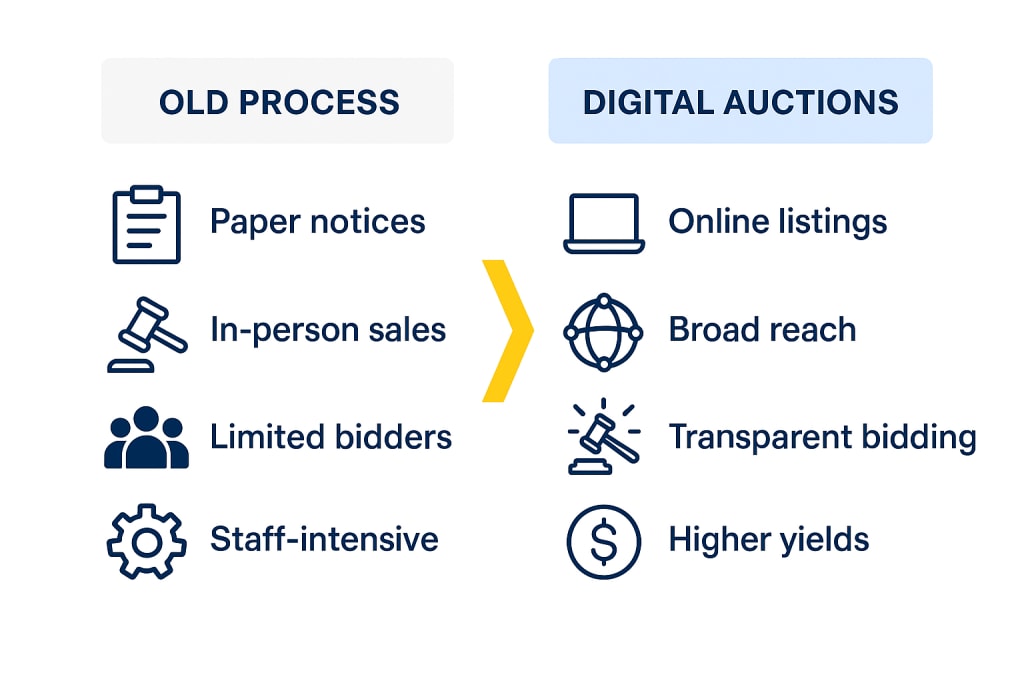When a small town gets recognized for digital excellence, most people think of things like online permitting or digital voting. But there’s another piece of the puzzle, one that’s often overlooked but has a big impact: how municipalities handle surplus disposal.
Towns like Gardner and Hubbardston in Massachusetts have already been celebrated for their innovation at the most recent annual Digital Government Summit in Boston. Their example shows that local governments are ready to take a broader look at all their processes, including how they manage surplus assets.
The Digital Government Trend Gains Momentum
All over the U.S. (and around the world), municipalities are under growing pressure to go digital. Citizens want services that work anytime, anywhere, whether that’s renewing a driver’s license online in California or paying property taxes through a 24/7 New York City portal. Governments want to cut costs and reduce friction. And transparency? At this point, it’s not optional; it’s expected.
Yet surplus auctions often lag behind. Too many cities are still running in-person sales, posting paper notices, or juggling inefficient manual processes.
That’s why the recognition of smaller towns at digital government summits is so interesting: it shows a willingness to embrace technology across the board. And if a municipality is already rethinking its systems, surplus sales deserve a seat at that table too.
Why Surplus Sales Belong in Digital Transformation
Efficiency & Cost Savings
Traditional auctions eat up staff time with cataloging, posting notices, managing bids, handling logistics, and tracking the money. Moving those workflows online reduces errors, saves hours, and frees up staff for higher-priority work.
Transparency & Trust
When surplus sales are managed through a public platform, citizens can see exactly what’s for sale, how bidding unfolds, and where the money goes. That level of visibility strengthens confidence in local government.
Wider Reach = Better Yield
Digital platforms bring in more bidders than the handful who can show up in person. More eyes and more competition usually mean higher returns for municipalities.
Data & Analytics
A digital system can reveal patterns: which types of assets sell well (or don’t), which departments rely most on disposal, and even seasonal trends. That data helps officials make smarter decisions about retiring and replacing assets.
Integration & Governance
Modern government systems are moving toward integration, connecting federal surplus auctions directly with property management and budgeting systems, so agencies can track assets from purchase to disposal.
Some cities also tie surplus disposal into fleet management platforms. When a police department retires a cruiser, the vehicle can be flagged for auction automatically, with the sale proceeds feeding back into the budget.
Linking surplus systems with procurement and asset tracking isn’t just convenient; it’s consistent with best practices in e-government and mirrors what’s happening in other areas like digital permitting and finance management.

Challenges to Inclusion — and How to Overcome Them
- Legacy resistance: Some stakeholders may dismiss surplus disposal as minor. Framing it as part of service excellence and fiscal responsibility can shift that mindset.
- Technical capacity: Smaller towns may not have IT staff to run digital systems. Partnering with established platforms or joining regional consortia helps lighten the load.
- Regulation & policy hurdles: State laws might still require certain notices or processes. Digital systems need to be fully compliant and transparent to oversight.
- Digital divide: Not every potential bidder is comfortable online. Offering hybrid models and bidder support helps bridge the gap.

Steps to Get Started
Pilot a small asset class
Start simple: try furniture, electronics, or a few small vehicles online. Use those early wins to build momentum.
Publicize success
When bids outperform expectations, share the story on social media or local news. It’s proof that the system works and can build support from staff, citizens, and neighboring towns.
Train staff & bidders
Offer step-by-step guides, webinars, and help desks that are easy to access and user-friendly. Reducing friction for both sides makes adoption smoother.
Measure & iterate
Track useful metrics like time to list an item, number of bidders, revenue per asset, and admin costs. Use the data to keep improving. Platforms such as Municibid often include built-in dashboards that automatically generate reports on listing speed, bid activity, and revenue trends.
Embed into digital strategy
Surplus auctions should sit alongside permitting, citizen portals, and finance systems in a town’s digital roadmap. Recognition for towns like Gardner and Hubbardston shows that communities of all sizes can take this approach.
The applause for Gardner and Hubbardston at the Massachusetts Digital Government Summit is a strong signal: municipalities are ready to go deeper with technology. Surplus disposal is too often left out of digital transformation plans, but it’s tailor-made for modernization. Done right, it’s efficient, transparent, revenue-boosting, and simply good governance.
If platforms like Municibid position themselves as essential infrastructure and not just a “nice add-on,” they’ll be perfectly placed to help municipalities ride this next wave of digital maturity.
Last Updated on October 8, 2025
